Establishing Embryogenic Tissue Culture Workflow for Pineapple Cultivar 73–50
Abstract
1. Introduction
2. Materials and Methods
2.1. Plant Material and Callus Induction
2.2. Media for Embryogenic Callus Development
2.3. Callus Growth Assessment and Statistical Analysis
2.4. Biolistic DNA Delivery
2.5. Agrobacterium-Mediated Transformation
2.6. Histochemical GUS Staining Assay
3. Results and Discussion
3.1. Optimization of Hormone Composition for 73–50 Pineapple Callus Maintenance
3.2. Classification of Developmental Stages of Pineapple Callus
- Friable embryogenic callus (FEC), consisting of loosely aggregated embryogenic cell clusters (20–500 cells, 5–100 µm in diameter). Highly dispersible, without visible structural organization, it is ideal for biolistic or Agrobacterium-mediated transformation and RNP uptake. This stage is equal to the ECC described by [11].
- Compact embryogenic callus (CEC) consists of non-dispersible embryogenic callus bodies of 3–6 mm. It is still suitable for transformation and corresponds to embryogenic tissue in [11].
- Pre-organogenic callus (POC) consists of more compact structures with the appearance of smooth or nodular surfaces, representing the beginning of cellular organization with cells exhibiting polarity.
- Organogenic callus (OC) is characterized by formation of shoot primordia, indicating the transition from embryogenesis, with visible leaf-like structures. There are some remaining embryogenic regions, but it is predominantly organogenic.
- Shoot-forming callus (SFC) is characterized by small rootless plantlets present among leaf-like structures. This is no longer true callus, transitioning to full shoot formation, and is ready for elongation and rooting.
3.3. Establishing Transient Expression in Friable Embryogenic Callus Using Biolistic and Agrobacterium-Mediated Approaches
3.4. Optimized Tissue Culture Procedure for Pineapple Cultivar 73–50
4. Conclusions
Author Contributions
Funding
Institutional Review Board Statement
Informed Consent Statement
Data Availability Statement
Acknowledgments
Conflicts of Interest
Abbreviations
| LB | Luria–Bertani medium |
| BAP | 6-Benzylaminopurine |
| NAA | a-Naphthaleneacetic acid |
| ABA | Abscisic acid |
| GUS | β-Glucuronidase |
| iGUS | GUS with intron |
| RNPs | Ribonucleoproteins |
| ECCs | Embryogenic cell clusters |
| CRISPR | Clustered Regularly Interspaced Short Palindromic Repeats |
| CIM | Callus induction medium |
| FEC | Friable embryogenic callus |
| CEC | Compact embryogenic callus |
| POC | Pre-organogenic callus |
| OC | Organogenic callus |
| SFC | Shoot-forming callus |
References
- Botella, J.R.; Smith, M. Genomics of Pineapple, Crowning The King of Tropical Fruits. In Genomics of Tropical Crop Plants; Moore, P.H., Ming, R., Eds.; Springer New York: New York, NY, USA, 2008; pp. 441–451. [Google Scholar]
- Firățoiu, A.R.; Chiurciu, I.A.; Marcuta, L.; Chereji, A.I.; Soare, E.; Voicu, V.; Marcuta, A. Study on The Production and Marketing of Pineapples Worldwide. In Proceedings of the 37th International Business Information Management Association (IBIMA), Cordoba, Spain, 1–2 April 2021. [Google Scholar]
- Sun, G.-M.; Zhang, X.-M.; Soler, A.; Marie-Alphonsine, P.A. Nutritional Composition of Pineapple (Ananas comosus (L.) Merr.). In Nutritional Composition of Fruit Cultivars; Simmonds, M.S.J., Preedy, V.R., Eds.; Academic Press: San Diego, CA, USA, 2016; pp. 609–637. [Google Scholar]
- de Ancos, B.; Sánchez-Moreno, C.; González-Aguilar, G.A. Pineapple composition and nutrition. In Handbook of Pineapple Technology; John Wiley & Sons, Ltd.: Hoboken, NJ, USA, 2017; pp. 221–239. [Google Scholar]
- Williams, D.D.F.; Fleisch, H. Historical review of pineapple breeding in Hawaii. Acta Hortic. 1993, 334, 67–76. [Google Scholar] [CrossRef]
- Taniguchi, G.; Sanewski, G.; Bartholomew, D.; Paull, R. Characteristics of the pineapple research institute of Hawaii hybrids 73–50 and 73–114. Pineapple News 2008, 15, 27–33. [Google Scholar]
- Li, D.; Jing, M.; Dai, X.; Chen, Z.; Ma, C.; Chen, J. Current status of pineapple breeding, industrial development, and genetics in China. Euphytica 2022, 218, 85. [Google Scholar] [CrossRef]
- Wakasa, K.; Koga, Y.; Kudo, M. Differentiation from in vitro culture of Ananas comosus. Jpn J. Breed. 1978, 28, 113–121. [Google Scholar]
- Reinhardt, D.; Bartholomew, D.; Vidigal, F.; Carvalho, A.; Pádua, T.; Junghans, D.; Matos, A. Advances in pineapple plant propagation. Rev. Bras. Frutic. 2018, 40, e-302. [Google Scholar] [CrossRef]
- Botella, J.R. Now for the hard ones: Is there a limit on CRISPR genome editing in crops? J. Exp. Bot. 2019, 70, 734–737. [Google Scholar] [CrossRef] [PubMed]
- Firoozabady, E.; Moy, Y. Regeneration of pineapple plants via somatic embryogenesis and organogenesis. In Vitro Cell. Dev. Biol.-Plant 2004, 40, 67–74. [Google Scholar] [CrossRef]
- Yusuf, N.H.M.; Latip, M.A.; Vijay Kumar, S. Efficient protocol for plant regeneration from callus cultures and Agrobacterium transformation of MD2 pineapple. Trans. Persat. Genet. Malays. 2016, 3, 1–10. [Google Scholar]
- Smith, M.K.; Ko, H.L.; Hamill, S.D.; Sanewski, G.M. Pineapple transformation: Managing somaclonal variation. In Proceedings of the International Symposium on Tropical and Subtropical Fruits, Cairns, Australia, 30 April 2002. [Google Scholar]
- Priyadarshani, S.V.G.N.; Cai, H.; Zhou, Q.; Liu, Y.; Cheng, Y.; Xiong, J.; Patson, D.L.; Cao, S.; Zhao, H.; Qin, Y. An Efficient Agrobacterium Mediated Transformation of Pineapple with GFP-Tagged Protein Allows Easy, Non-Destructive Screening of Transgenic Pineapple Plants. Biomolecules 2019, 9, 617. [Google Scholar] [CrossRef] [PubMed]
- Trusov, Y.; Rookes, J.E.; Tilbrook, K.; Chakravorty, D.; Mason, M.G.; Anderson, D.; Chen, J.G.; Jones, A.M.; Botella, J.R. Heterotrimeric G protein γ subunits provide functional selectivity in Gbetagamma dimer signaling in Arabidopsis. Plant Cell 2007, 19, 1235–1250. [Google Scholar] [CrossRef] [PubMed]
- Espinosa, P.; Lorenzo, J.; Iglesias, A.; Yabor, L.; Menéndez, E.; Borroto, J.; Hernández, L.; Arencibia, A. Production of pineapple transgenic plants assisted by temporary immersion bioreactors. Plant Cell Rep. 2002, 21, 136–140. [Google Scholar] [CrossRef]
- Firoozabady, E.; Gutterson, N. Cost-effective in vitro propagation methods for pineapple. Plant Cell Rep. 2003, 21, 844–850. [Google Scholar] [CrossRef] [PubMed]
- Smith, M.; Drew, R. Current applications of tissue culture in plant propagation and improvement. Funct. Plant Biol. 1990, 17, 267–289. [Google Scholar] [CrossRef]
- Sripaoraya, S.; Marchant, R.; Power, J.B.; Davey, M.R. Plant regeneration by somatic embryogenesis and organogenesis in commercial pineapple (Ananas comosus L.). In Vitro Cell. Dev. Biol.-Plant 2003, 39, 450–454. [Google Scholar] [CrossRef]
- Wan Rizzal, W.; Janna, O.; Rusli, I.; Nur Ashikin, P. Comparison in Multiplication Rate of MD2 Pineapple Micropropagation with Liquid MS, Solid MS and Temporary Immersion System. Innov. Plant Product. Qual. 2014, 22, 205–209. [Google Scholar]
- Firoozabady, E.; Heckert, M.; Gutterson, N. Transformation and regeneration of pineapple. Plant Cell Tissue Organ. Cult. 2006, 84, 1–16. [Google Scholar] [CrossRef]
- Hajdukiewicz, P.; Svab, Z.; Maliga, P. The small, versatile pPZP family of Agrobacterium binary vectors for plant transformation. Plant Mol. Biol. 1994, 25, 989–994. [Google Scholar] [CrossRef] [PubMed]
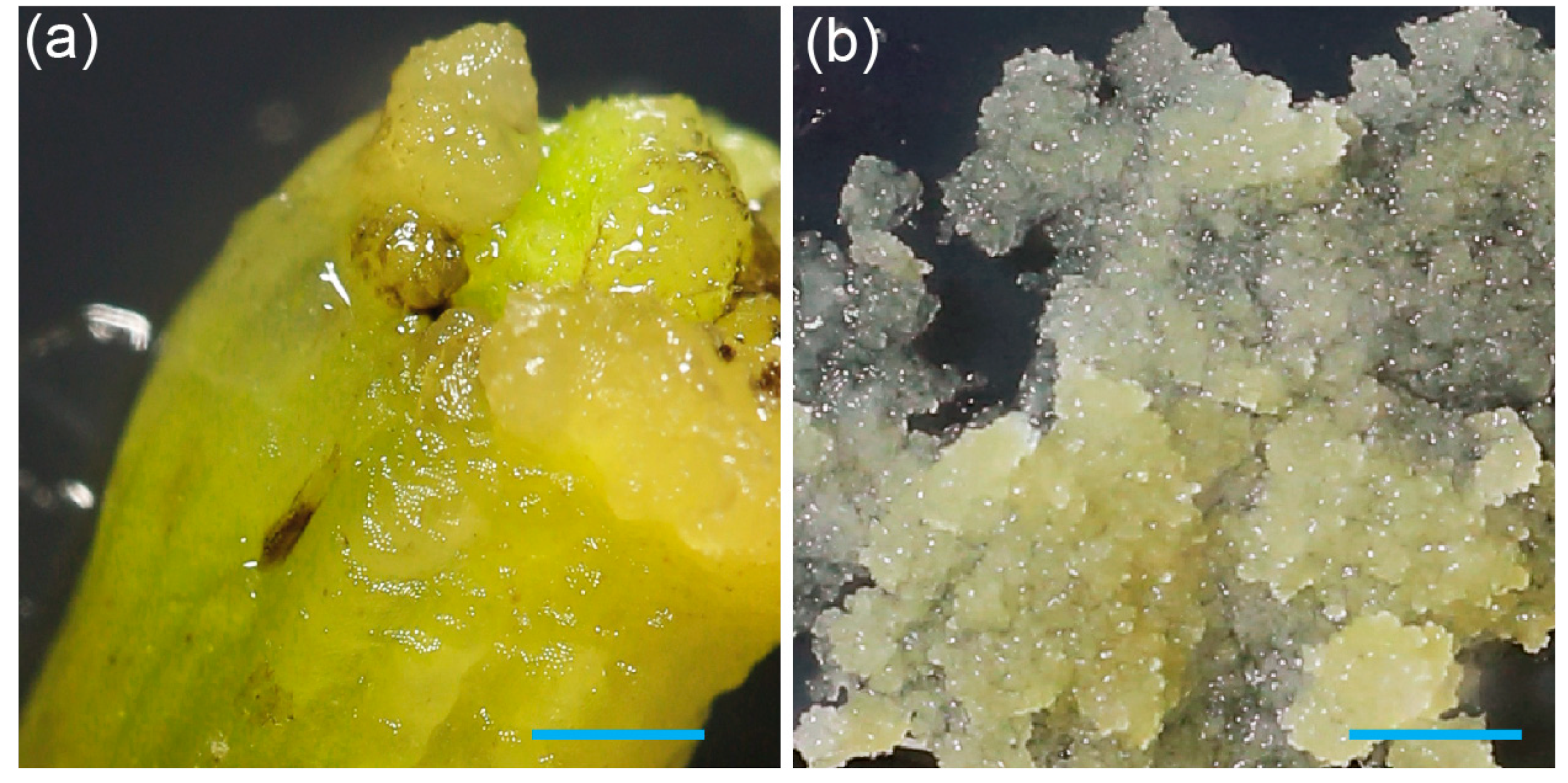
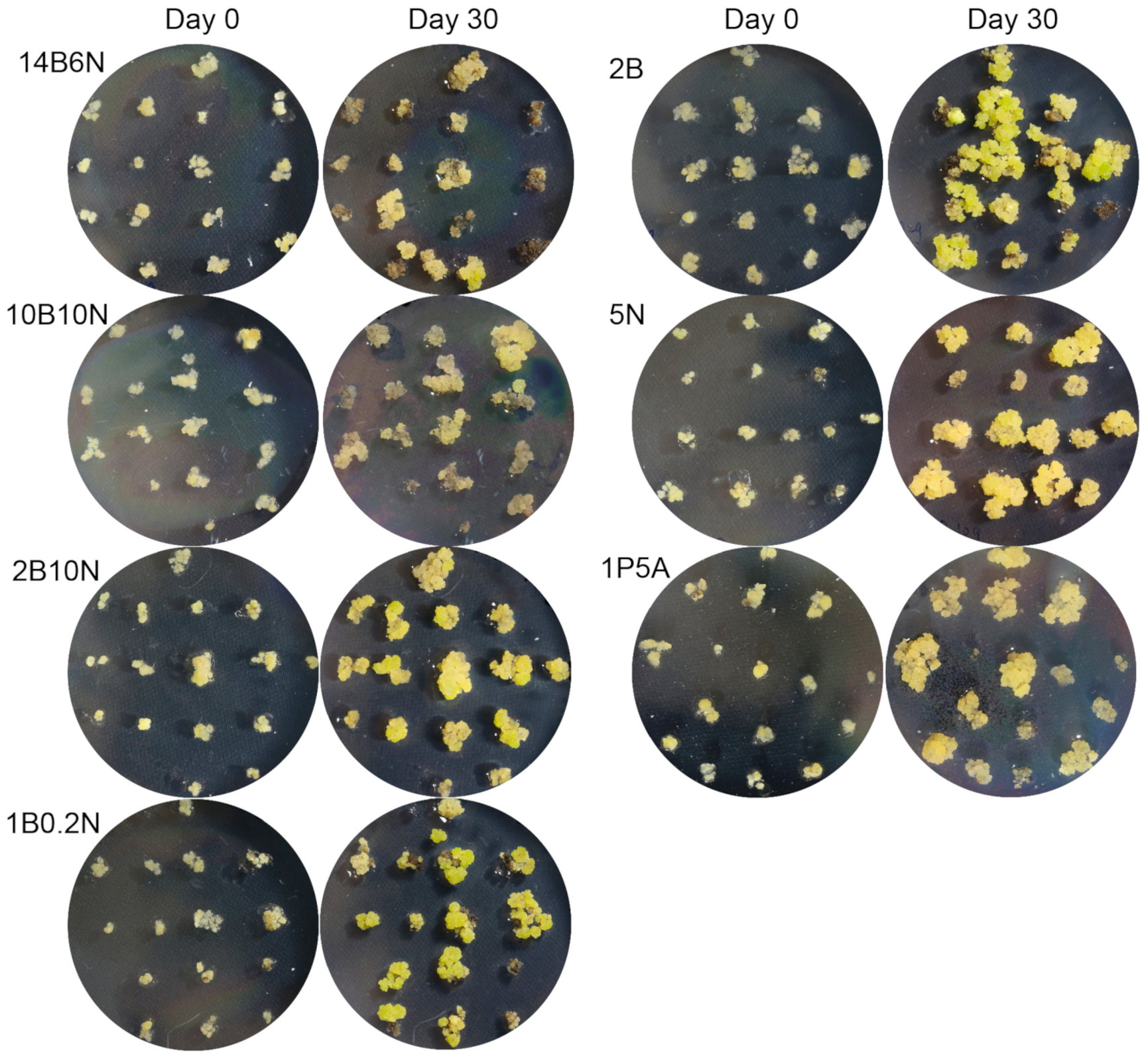

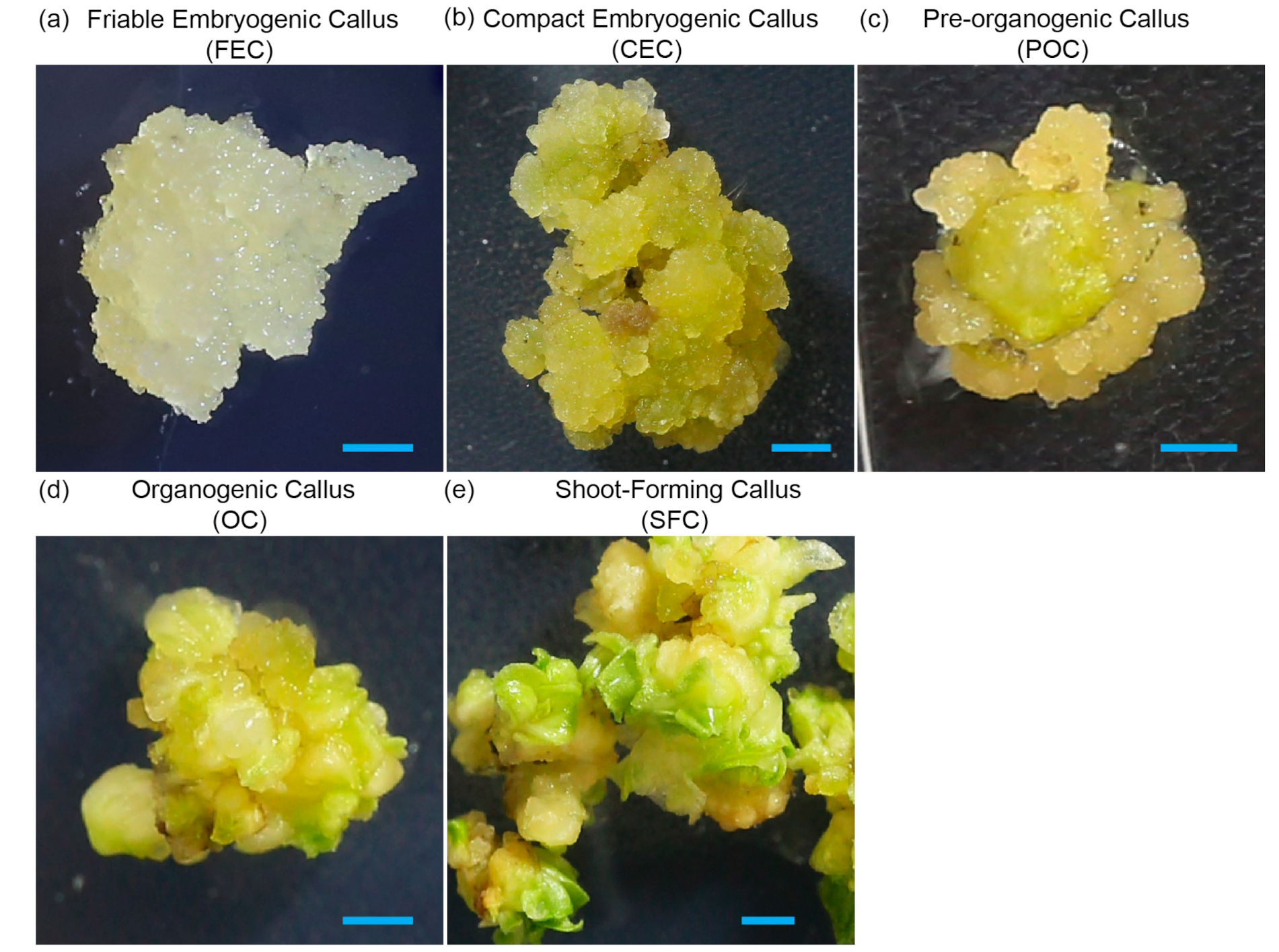
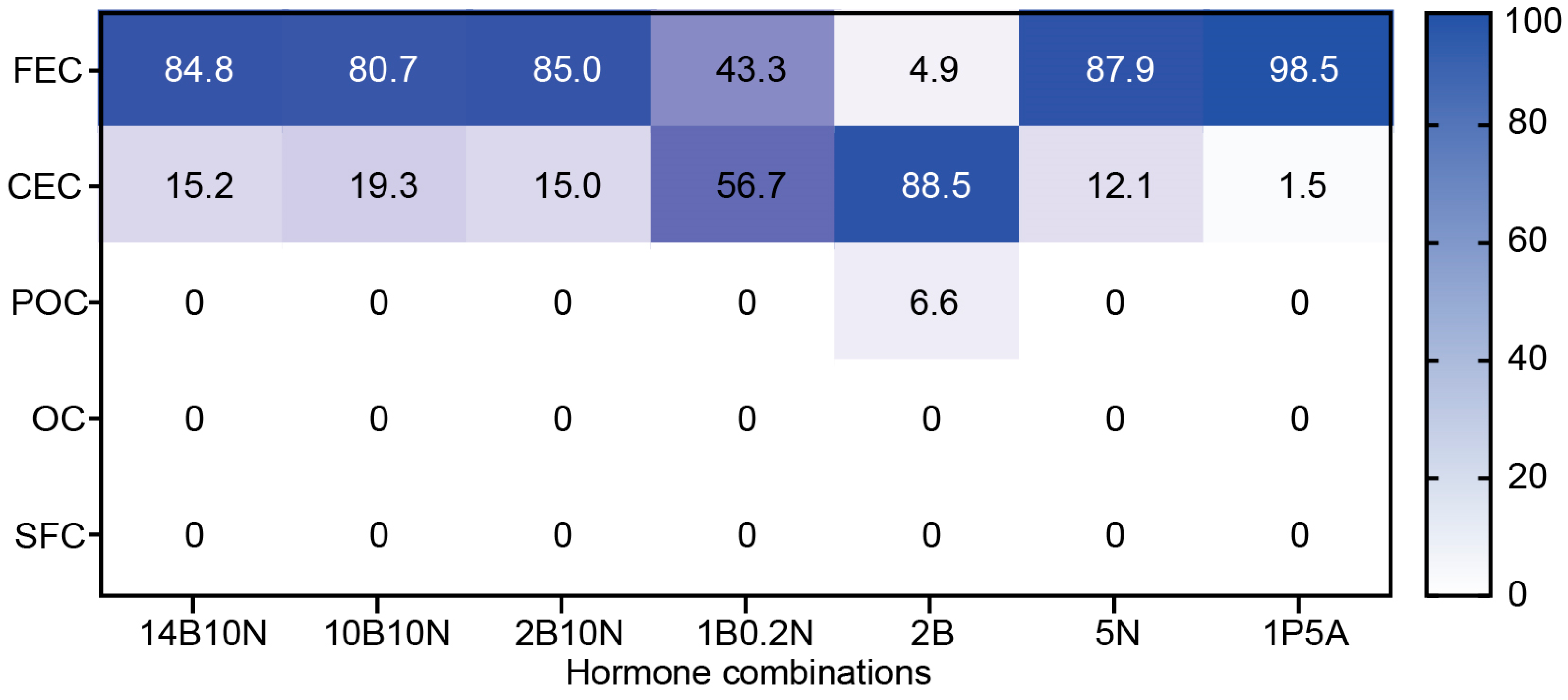

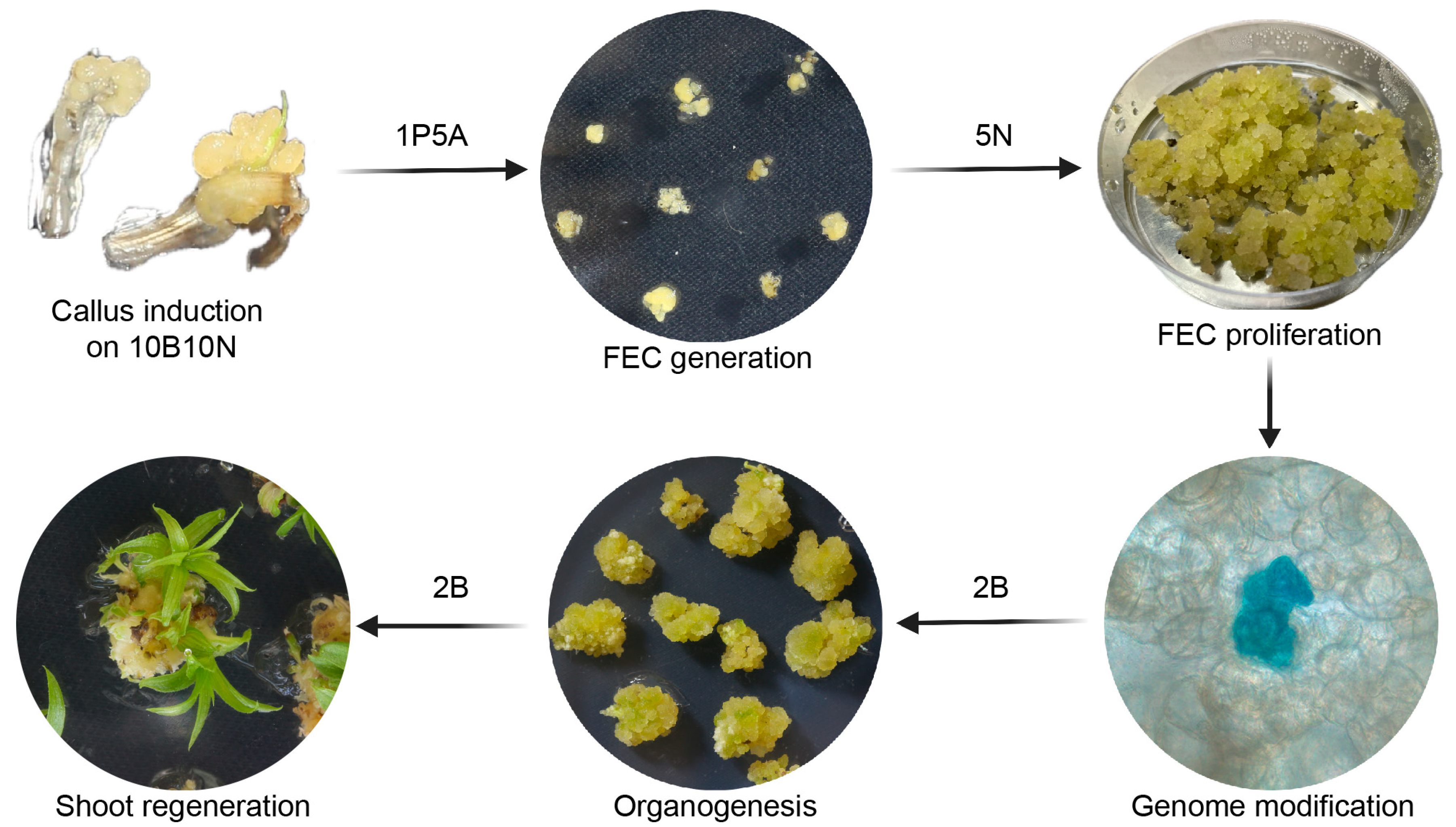
| Name | Hormone Combination | Reference |
|---|---|---|
| 14B6N | 14 mg/L BAP and 6 mg/L NAA | [12] |
| 10B10N | 10 mg/L BAP and 10 mg/L NAA | [13] |
| 2B10N | 2 mg/L BAP and 10 mg/L NAA | |
| 1B0.2N | 1 mg/L BAP and 0.2 mg/L NAA | [14] |
| 2B | 2 mg/L BAP | |
| 5N | 5 mg/L NAA | |
| 1P5A | 1 mg/L picloram and 5 µg/L ABA with 1 g/L glutamine | [11] |
Disclaimer/Publisher’s Note: The statements, opinions and data contained in all publications are solely those of the individual author(s) and contributor(s) and not of MDPI and/or the editor(s). MDPI and/or the editor(s) disclaim responsibility for any injury to people or property resulting from any ideas, methods, instructions or products referred to in the content. |
© 2025 by the authors. Licensee MDPI, Basel, Switzerland. This article is an open access article distributed under the terms and conditions of the Creative Commons Attribution (CC BY) license (https://creativecommons.org/licenses/by/4.0/).
Share and Cite
Cheng, M.; Trusov, Y.; Liu, G.; Mao, Y.; Botella, J.R. Establishing Embryogenic Tissue Culture Workflow for Pineapple Cultivar 73–50. Genes 2025, 16, 549. https://doi.org/10.3390/genes16050549
Cheng M, Trusov Y, Liu G, Mao Y, Botella JR. Establishing Embryogenic Tissue Culture Workflow for Pineapple Cultivar 73–50. Genes. 2025; 16(5):549. https://doi.org/10.3390/genes16050549
Chicago/Turabian StyleCheng, Ming, Yuri Trusov, Guoquan Liu, Yanfei Mao, and Jose Ramon Botella. 2025. "Establishing Embryogenic Tissue Culture Workflow for Pineapple Cultivar 73–50" Genes 16, no. 5: 549. https://doi.org/10.3390/genes16050549
APA StyleCheng, M., Trusov, Y., Liu, G., Mao, Y., & Botella, J. R. (2025). Establishing Embryogenic Tissue Culture Workflow for Pineapple Cultivar 73–50. Genes, 16(5), 549. https://doi.org/10.3390/genes16050549






